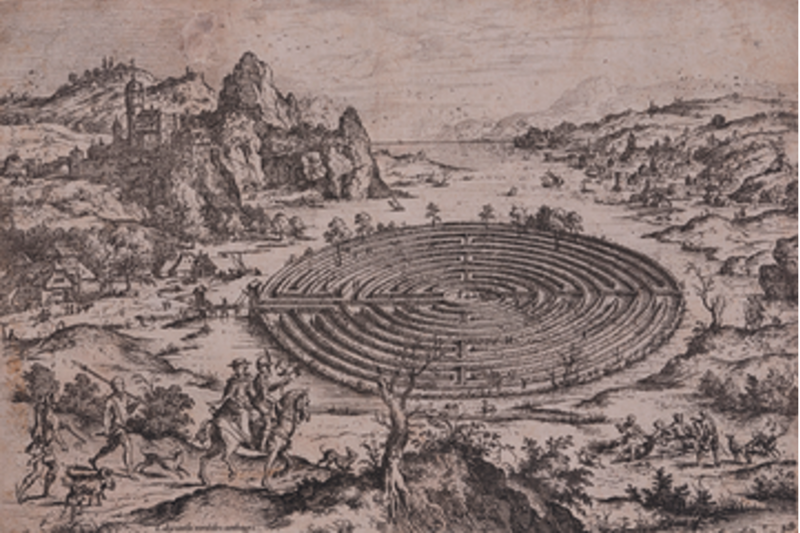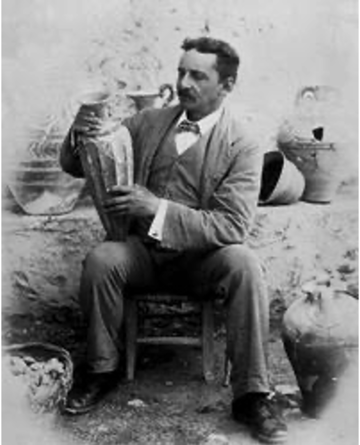LABYRINTH: KNOSSOS, MYTH & REALITY

LABYRINTH: KNOSSOS, MYTH & REALITY
The Ashmolean’s first exhibition in 2023 runs 10 Feb to 30 July and is already a ‘must-visit’ in 2023
Published: 27 March 2023
Share this article
The Ashmolean’s first exhibition in 2023 explores one of the most infamous of classical myths and celebrated stories of modern archaeology: the Labyrinth, the Minotaur and the Palace of Knossos. The exhibition features more than 200 objects, over 100 of which are on loan from Athens and Crete. They will be shown, for the first time in more than a century, alongside the Ashmolean’s unrivalled collections and the archive of photographs and documents that illustrate the exciting moments when the Palace of Knossos was uncovered between 1900–1905.
In Greek myth the Labyrinth at Knossos held the Minotaur, a monstrous bull-human hybrid awaiting his sacrificial victims. The story remains one of the most enduring of classical myths and, unsurprisingly, Knossos is now one of the most visited archaeological sites in Greece.

The exhibition traces the story of the excavation of Knossos at Crete. For centuries, travellers searched the island for the mythical Labyrinth, leaving a trail of myths, misleading maps, and misread archaeological evidence until 1878 when the remains of an ancient building at Knossos were discovered by a Cretan businessman and scholar, Minos Kalokairinos. Local authorities prevented him from properly excavating the site as Crete was under the partial control of the Ottoman Empire, and until it gained independence, any significant finds were at risk of being removed to Constantinople (Istanbul). Kalokairinos’s discoveries attracted international attention, and archaeologists from various countries competed for the future rights to excavate. In 1900, it was the British archaeologist and Keeper (director) of the Ashmolean, Sir Arthur Evans (1851–1941), who was granted permission to dig by the Cretan authorities. (Shown right, at the Knossos Palace in 1901)
Evans began his excavation, convinced that this building was the Labyrinth of myth. He rapidly found colourful frescoes, clay tablets showing an early system of writing and even a room with an intact stone throne on which he imagined the rulers sat. He referred to this labyrinthine building as the ‘Palace of Minos,’ and he was able to establish that it was around 4,000 years old and built during the Bronze Age. He popularised the term ‘Minoan’ to describe the civilisation of Crete in this period.
The exhibition features some of the finest Minoan objects that Evans uncovered, from everyday objects like decorated pottery to elaborate sculptures, many on loan from the Heraklion Archaeological Museum. They are reunited with drawings made during the excavation from the Ashmolean’s Sir Arthur Evans archive. Some of the drawings show the process of reconstructing the site and its finds, providing an insight into Evans’s controversial concrete restorations of the Palace of Minos in the mid-20th century.
The size and scale of the site meant excavation work at Knossos continued at times throughout the 20th century and still continues today. The final room of the exhibition displays discoveries made in the post-war period, and many recent finds. These include objects verifying Knossos as the site of the earliest known farming settlement in Europe, established in around 7000 BCE, as well as incredible objects uncovered in cemeteries and religious sanctuaries in the surrounding areas, showing that Knossos flourished for thousands of years before it was largely abandoned in around 800 BCE. Among the recent finds on display is a spectacular Bronze Age dagger with inlaid gold and silver griffins, the first of its kind found on Crete. The exhibition ends with the chilling discovery, made in 1979, that appeared to show evidence of a ritual human sacrifice – challenging public perception of the Minoans as peaceful and providing a tantalizing hint of the Minotaur myth.
Dr Xa Sturgis, Director of the Ashmolean, says: 'This is an exhibition that only the Ashmolean could mount. Since 1903, the Museum has held the largest and most significant collection of Minoan archaeology outside Crete thanks to one of my predecessors as Ashmolean Director, Sir Arthur Evans.
‘Long thought of as an archaeological pioneer, Evans and his interventions at Knossos are now being reconsidered in their historical context. The exhibition offers both an exploration of Minoan culture and Greek myth, and a deeper look at British archaeological history.’
Exhibition: Labyrinth: Knossos, Myth & Reality
Dates: 10 February–30 July 2023
Hours: Daily, 10am–5pm
Venue: The John Sainsbury Exhibition Galleries, Floor 3, Ashmolean Museum, Beaumont Street, Oxford OX1 2PH
Admission: £7.65–£17.00, available at the Museum or online at ashmolean.org. Concessionary rates available for alumni with a My Oxford Card
Publication: The exhibition is accompanied by a fully illustrated catalogue, £25, available at the Ashmolean or online















